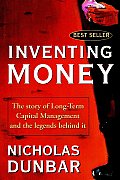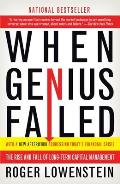 Inventing Money: The Story of Long-Term Capital Management and the legends behind it
Inventing Money: The Story of Long-Term Capital Management and the legends behind it
by Nicholas Dunbar
 When Genius Failed: The Rise and Fall of Long-Term Capital Management
When Genius Failed: The Rise and Fall of Long-Term Capital Management
by Roger Lowenstein
Just when you think you’ve got it all figured out, Life comes along, sneaking up behind you with a bit of lead piping, to steal from P.G. Wodehouse.
The story of Long Term Capital Management is the story of The Smartest Guys in the World, and how maybe they just managed to outsmart themselves. In the meantime, they almost collapsed the world financial system, gave hedge funds a bad name, and called into question 30 years of financial orthodoxy.
Since finance is one of the intersections of math and men, Long Term Capital Management represents the failure of both. In Inventing Money, Nicholas Dunbar emphasizes the math. Roger Lowenstein’s When Genius Failed emphasizes the men.
LTCM based their strategy on Modern Portfolio Theory. MPT is essentially Brownian motion – random motion with normally-distributed action – applied to financial markets. It produced the famed Black-Scholes equation, now used statutorily for pricing options.
The problem is, they forgot the fine print. The normal distribution is one simplifying assumption. Another is that returns in different markets are uncorrelated, that is, what one does has no effect on the others. Another is that markets are always liquid – they trade at the smallest tick, and unlike the Hotel California, you can actually leave anytime you want.
The problem is, when everyone heads for the exits, none of these conditions holds. LTCM essentialy was making the same bet all over the world – that the difference in interest rates between government and corporate bonds would narrow. When people lost faith in overseas private credit in the wake of 1997 and 1998 currency meltdowns, they fled to quality – US & western government bonds. This forced down US interest rates, and forced up other interest rates.
Things didn’t get any better for LTCM when their competitors began front-running, or trading ahead of them, both denying them profits and widening these spreads even further.
This meant that their basic models estimating their losses failed, because markets were no longer behaving independently. Worse, they couldn’t sell when they wanted – their positions were too large, and the markets were moving too quickly.
I read Inventing Money just as I had finished a Risk Management course in business school. The professor was quite good at stressing concepts over equations, but as I read, I couldn’t help thinking that he could have assigned Dunbar’s book as supplementary reading. Dunbar follows the history of Modern Portfolio Theory as well as I’ve seen in any lay book, tying it in with the bets that LTCM was placing at the time.
While he certainly devotes chapters to the collapse, Dunbar spends most of his time discussing the rise of derivatives markets, and the boost that Black-Scholes gave them.
It wasn’t like the bankers didn’t know this sort of thing could happen. They had devised a measure called “Value at Risk,” or VAR, which estimated, again according to MPT, how much they could expect to lose in the worst month out of any 20. Or 100. Armed with these calculations, fund managers believed they could calculate how much cushion they needed.
VAR had its limits. In a 1995 article in the Financial Analysts Journal Tanya Styblo Beder made the following all-too-prescient statements:
Although a model may produce adequate views of capital at risk on an overnight or weekly basis, it may produce inadequate risk views over time horizons of several months, a year, or longer. For example, the calculation of short-horizon VAR may be misleading for customized or exotic products that cannot be liquidated und the assumed time horizon.
and
As experience during the European currency crisis, the Gulf War, and the Mexican peso crisis, not only are the key factors such as “maximum” volatility difficult to predict but also correlation relationships change substantially during extreme market moves. (emphasis added -ed.)
They can’t say they weren’t warned. But what they did with the warning, like defenders of the earth-centered solar system, was to go back and tinker with the model, secure and comfortable in the rightness.
When Genius Failed spends much more time with the people, fitting in the finance concepts along the way. Lowenstein’s extended description of the frantic inter-bank negotiations puts you right in the room. That the bankers, who frankly hate each other, are all sinking in the same boat, doesn’t keep them from trying to screw each other as they plug the holes.
The personalities stand out in bold relief. Meriwether is confident, affable, and takes care of his people. Victor Haghani should be wearing an Al Davis jumpsuit and grabbing free drinks off the tray. Born in 1930s Europe, Lawrence Hilibrand would have ended up running some Balkan fascist state. Future Senator and would-be Governor of New Jersey Jon Corzine comes across as well-meaning, but in over his head, even standing on his tip-toes.
And what of the Really Smart Guys, the academics who put the sand under the foundation in the first place? They provided much of marquee value for the company, but afterwards tried to portray themselves as uninvolved. Fischer Black died warning of the potential misues of this models, but Merton and Scholes, while nervous about the direction the company took towards the end, didn’t have the force of personality to put on the brakes. They produced theory. Haghani and Hiliband produced money.
Lowenstein also covers a few topics in detail largely missing from Dunbar’s account. The eagerness of banks to do business with LTCM is dramatized by UBS’s willingness to sell LTCM a call option on their own fund. UBS hedged that risk by investing in LTCM. The only way that UBS wouldn’t have to pay off the option was if the fund lost money, meaning that UBS would lose money. He also details the miswording – deliberate or not – of Warren Buffet’s last-minute offer to rescue the fund.
In the years since, LTCM has become the poster child for what can go wrong in a market. Both James Surowiecki and Benoit Mandelbrot cite it in their recent books. Scholarly articles are still being written on what went wrong.
These two books are best read together for their different perspectives on this seminal event in US financial history.